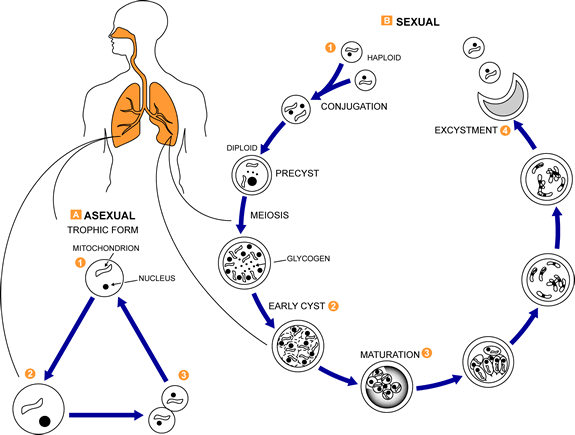Pneumocystis jirovecii pneumonia pathophysiology
|
Pneumocystis jirovecii pneumonia Microchapters |
|
Differentiating Pneumocystis jirovecii pneumonia from other Diseases |
|
Diagnosis |
|
Treatment |
|
Case Studies |
|
Pneumocystis jirovecii pneumonia pathophysiology On the Web |
|
American Roentgen Ray Society Images of Pneumocystis jirovecii pneumonia pathophysiology |
|
Pneumocystis jirovecii pneumonia pathophysiology in the news |
|
Risk calculators and risk factors for Pneumocystis jirovecii pneumonia pathophysiology |
Editor-In-Chief: C. Michael Gibson, M.S., M.D. [1]
Overview

Pneumocystis jirovecii (previously classified as Pneumocystis carinii) was previously classified as a protozoa. Currently, it is considered a fungus based on nucleic acid and biochemical analysis.
This is a generalized life cycle proposed by John J. Ruffolo, Ph.D. (Cushion, MT, 1988) for the various species of Pneumocystis. These fungi are found in the lungs of mammals where they reside without causing overt infection until the host's immune system becomes debilitated. Then, an oftentimes lethal pneumonia can result. 1 Asexual phase: trophic forms replicate by mitosis 2 to 3. Sexual phase: haploid trophic forms conjugate 1 and produce a zygote or sporocyte (early cyst) 2. The zygote undergoes meiosis and subsequent mitosis to produce eight haploid nuclei (late phase cyst) 3. Spores exhibit different shapes (such as, spherical and elongated forms). It is postulated that elongation of the spores precedes release from the spore case. It is believed that the release occurs through a rent in the cell wall. After release, the empty spore case usually collapses, but retains some residual cytoplasm 4. A trophic stage, where the organisms probably multiply by binary fission is also recognized to exist. The organism causes disease in immunosuppressed individuals.